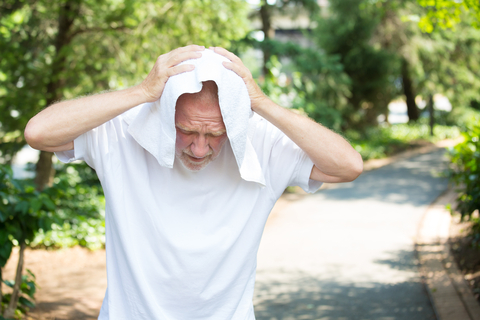
Sunburn, dehydration, heat exhaustion, heat stroke
Australia is known as the ‘sunburnt country’ and lays claim to many of the world’s heat records, including the hottest summer climate and the greatest amount of sunshine. Spanning from the northern regions which are more tropical and then ranging from grasslands, desert and rainforests, down to the south, which experiences four seasons and temperatures that can exceed 40°C during the summer months, January being the hottest month.
Sunburn, dehydration, heat exhaustion and heat stroke are all conditions which can develop from exposure to the sun and/or high temperatures and can produce symptoms that range from mild to severe, debilitating and even life-threatening.
- Sunburn is the skin reacting to the ultraviolet (UV) radiation from the sun, a process that can occur in less than 15 minutes. It is important to be aware that UV rays can damage your skin even on cool and cloudy days. Australia has one of the highest rates of skin cancer in the world and all sun exposure, including tanning without burning, raises your risk of skin cancer.
- Dehydration occurs when your body is lacking in sufficient water and, with that, essential electrolytes. Excessive heat, sweating or sun exposure while doing physical activity in higher temperatures can lead to dehydration and serious metabolic issues. Severe dehydration is a potentially dangerous condition that requires prompt medical attention.
- Heat exhaustion can hit suddenly or gradually, usually after physical activity in the heat or becoming dehydrated. Symptoms range from excessive sweating, cramps, dizziness, headache, nausea, vomiting and confusion. The condition is serious and can lead to heat stroke, so it is vital to be able to recognise the signs of heat exhaustion and take appropriate steps to cool the body down.
- Heat stroke is a life-threatening condition that can rapidly develop from heat exhaustion, with symptoms including hot, dry skin, rapid pulse, no sweating, collapse and loss of consciousness.
Where?
Depending on the season and the time of day, all regions in Australia can potentially pose a risk of heat-related illness. In the northern regions, the climate is tropical so the risk is high all year round, while the seasonal weather of the south means the higher risk time is during summer - December through until March. It is worth noting however that activities in or on reflective surfaces – such as snow skiing and water sports - also increase the risk of sun exposure at any time of the year. Bear in mind that dehydration can also result from vomiting/ diarrhoea/ fever, as well as being in a dry environment, such as an aircraft cabin on a lengthy flight.
Risk to travellers
Heat-related illnesses pose a potential risk to any traveller so don’t forget to stay cool and hydrated, and avoid strenuous activity and direct sun exposure between 10am and 3pm in particular, the hottest time of day.
A guide on prevention
Preparation and suitable protection for anyone participating in at-risk activities is the key to preventing heat-related illnesses.
- Plan outdoor activities earlier or later in the day.
- Sunscreen with a minimum SPF30+ UV ray protection should be applied 20 minutes before going outdoors and the recommendation is to re-apply it every 2 hours.
- Protective clothing, bearing in mind that clothing also has a UV ray protection index; this is especially important during water activities.
- Hats should have a broad brim as that will offer better protection for the ears and back of the neck.
- Shade will offer shelter from direct sunlight, however UV rays can still have a burning effect by bouncing off reflective surfaces. If you are near or on the water, sand, snow or cement, sunscreen is still advised.
- Sunglasses rated UV400 or higher will block 99.9% of UV rays; a wrap-around style is best.
- Hydrate - always carry enough water so that you can manage the recommended intake of one litre per person per hour, starting even before you head outdoors. Don’t rely on your degree of thirst to decide when to drink. Avoid alcohol and caffeine. To determine if you’re adequately hydrated, your urine should be pale and clear. Sports drinks can be useful for replacing electrolytes if you're engaging in physical activity, but for the different needs of infants and young children, a commercial paediatric rehydration solution is recommended.
Treatment
Sunburn: Mild sunburn can be treated with cooling measures such as short, cool baths together with pain relief from a nonsteroidal anti-inflammatory drug such as ibuprofen, however severe sunburn, where blistering has occurred, requires medical attention.
Dehydration: In mild cases, promptly treat by replacing the body’s fluid levels with clear fluids such as water, or use an oral rehydration solution which will replace lost electrolytes. Severe dehydration requires medical attention which may include the administration of intravenous fluids.
Heat exhaustion: It is important to cease the activity immediately, hydrate (as above) and cool down. Rest in the shade, cool bathing, ice packs and/or get into an air-conditioned building or car.
Heat stroke: Find shade and seek urgent medical attention (call an ambulance). If available, ice packs placed against the neck, under the arms, and in the groin area will help cool the person while awaiting medical assistance.
Better Health: https://www.betterhealth.vic.gov.au
Cancer Council: https://www.cancer.org.au
Health Direct: https://www.healthdirect.gov.au
Royal Flying Doctor: https://www.flyingdoctor.org.au
